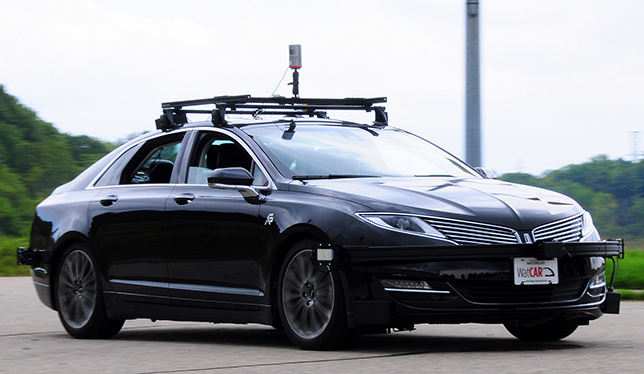Years of research tells us that human error has long been the biggest factor behind road fatalities in Canada. With the Ontario government’s recent approval of a three-year self-driving car research program at the University of Waterloo, Canadian roads could become a lot safer.
“The autonomous systems … allow the car to stop and to pick up on danger before the accident happens,” says Pearl Sullivan, dean of the faculty of engineering at U of Waterloo and a researcher with the Waterloo Centre for Automotive Research, or WatCAR. The WatCAR project is the first university-based initiative to be granted permission to test self-driving cars on Ontario roads.
Each researcher working on the project will apply their expertise to the autonomous system of a Lincoln MKZ hybrid sedan, nicknamed “Autonomoose”, and help solve problems as they arise, says Krzysztof Czarnecki, a professor in the department of electrical and computer engineering at U of Waterloo. As contributors program the car’s systems, including lidar, forward-visioning and mapping, the vehicle will “learn” to drive. For example, while a human drives the car, the vehicle’s lidar system takes a 360-degree image of the driving surface, which enables the car to “remember” the road.
Ross McKenzie, managing director for WatCAR, says that so far they have been testing the car in parking lots and on a test track. The vehicle has already learned to respond to some of the challenges it may face on the road – it can detect objects, for example – and in November, it was tested in harsh weather conditions to recognize obstacles on winter roads.
“We had a parking lot that we tested on in Stratford [Ontario] and we didn’t have plows and salt trucks come in because we wanted the vehicle to experience trying to drive on an icy slippery surface,” says Mr. McKenzie. As the researchers expected, the car had difficulty driving under those conditions. “The laser beam [of the lidar system] refracts off the surface of ice different than it would off of bare pavement on the road and it actually thinks that the ground is further down than it is … It’s almost like it sees a pothole,” says Mr. McKenzie.

The research team welcomes such mistakes as an opportunity to adjust and reprogram the car’s software and to ultimately improve the car’s self-driving capabilities.
Dr. Czarnecki says the car will most likely be tested for the first time on public roads this spring. Mr. McKenzie assures that throughout the tests “there is never a time when the vehicle can’t instantly be taken over by a human operator.” He points out that the real danger facing a passenger in an autonomous vehicle, however, is the potential mistakes other cars – and their human drivers – will make on the road.
“Autonomous vehicles are programmed to be very conservative and err on the side of caution,” Mr. McKenzie says. “The main challenge will be to make it robust enough to handle those random maneuvers that human operators make.”